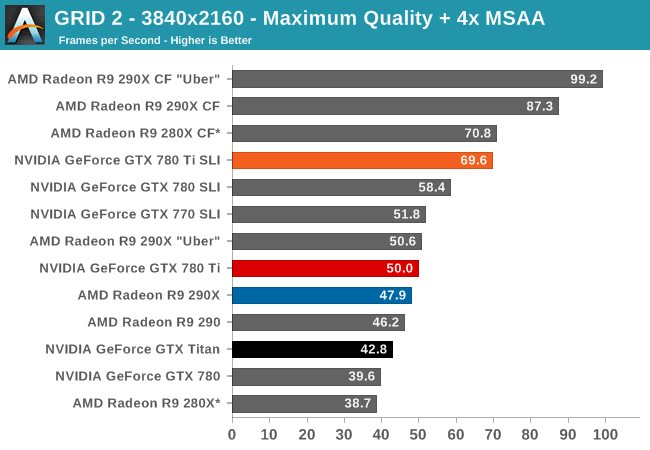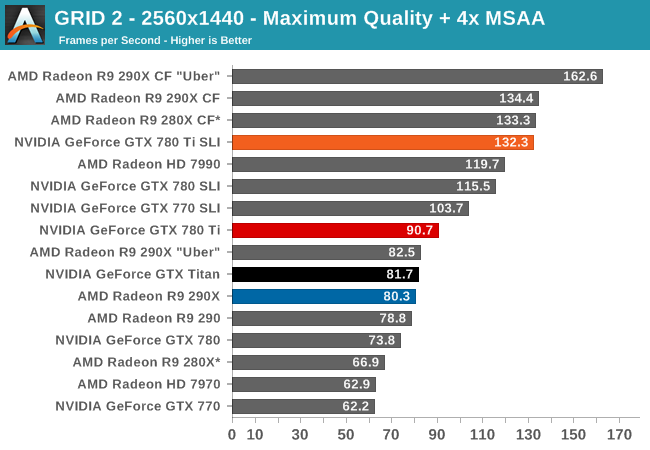The NVIDIA GeForce GTX 780 Ti Review
by Ryan Smith on November 7, 2013 9:01 AM ESTGRID 2
The final game in our benchmark suite is also our racing entry, Codemasters’ GRID 2. Codemasters continues to set the bar for graphical fidelity in racing games, and with GRID 2 they’ve gone back to racing on the pavement, bringing to life cities and highways alike. Based on their in-house EGO engine, GRID 2 includes a DirectCompute based advanced lighting system in its highest quality settings, which incurs a significant performance penalty but does a good job of emulating more realistic lighting within the game world.


When it comes to GRID even cranking up the game’s quality settings to maximum hardly does anything to slow down our cards. At 90fps the GTX 780 Ti once again takes the top spot while delivering an extremely high framerate. This ultimately puts the GTX 780 Ti ahead of the 290X by 13%, while also beating the other GK110 cards by a bit more than average at 11% for GTX Titan and 23% for GTX 780.
Otherwise, moving on to 4K and multi-GPU setups, NVIDIA’s limited scaling once more becomes an issue. At 50fps for a single GTX 780 Ti NVIDIA starts off well enough, but we still need a second GPU to get above 60fps. And though GTX 780 Ti SLI will get us there, 290X CF and AMD’s superior scaling will get AMD there with room to spare.










302 Comments
View All Comments
yuko - Monday, November 11, 2013 - link
for me neither of them is gamechanger ... gsync, shield ... nice stuff i don't needmantle: another nice approach to create an semi-closed-standard .. it's not that directX or opengl is allready existing and working quite good, no , we need another low level standard where amd creates the api (and to be honest, they would be quite stupid not optimizing it for their hardware).
I cannot believe and hope that mantle will flop, it does no favor to customers and the industry. It's just good for the marketing but has no real world use.
Kamus - Thursday, November 7, 2013 - link
Nope, it's confirmed for every frostbite 3 game coming out, that's at least a dozen so far, not to mention it's also officially coming to starcitizen, which runs on cryengine 3 I believe.But yes, even with those titles it's still a huge difference, obviously.
That said, you can expect that any engine optimized for GCN on consoles could wind up with mantle support, since the hard work is already done. And in the case of star citizen... Well, that's a PC exclusive, and it's still getting mantle.
StevoLincolnite - Thursday, November 7, 2013 - link
Mantle is confirmed for all Frostbite powered games.That is, Battlefield 4, Dragon Age 3, Mirrors Edge 2, Need for Speed, Mass Effect, StarWars Battlefront, Plant's vs Zombies: Garden Warfare and probably others that haven't been announced yet by EA.
Star Citizen and Thief will also support Mantle.
So that's EA, Cloud Imperium Games, Square Enix that will support the API and it hasn't even released yet.
ahlan - Thursday, November 7, 2013 - link
And for Gsync you will need a new monitor with Gsync support. I won't buy a new monitor only for that.jnad32 - Thursday, November 7, 2013 - link
http://ir.amd.com/phoenix.zhtml?c=74093&p=irol...BOOM!
Creig - Friday, November 8, 2013 - link
Gsync will only work on Kepler and above video cards.So if you have an older card, not only do you have to buy an expensive gsync capable monitor, you also need a new Kepler based video card as well. Even if you already own a Kepler video card, you still have to purchase a new gsync monitor which will cost you $100 more than an identical non-gsync monitor.
Whereas Mantle is a free performance boost for all GCN video cards.
Summary:
Gsync cost - Purchase new computer monitor +$100 for gsync module.
Mantle cost - Free performance increase for all GCN equipped video cards.
Pretty easy to see which one offers the better value.
neils58 - Sunday, November 10, 2013 - link
As you say Mantle is very exciting, but we don't know how much performance we are talking about yet. My thinking on saying that crossfire was AMD's only answer is that in order to avoid the stuttering effect of dropping below the Vsync rate, you have to ensure that the minimum framerate is much higher, which means adding more cards or turning down quality settings. If Mantle turns out to be a huge performance increase things might work out, but we just don't know.Sure, TN isn't ideal, but people with gaming priorities will already be looking for monitors with low input lag, fast refresh rates and features like backlight strobing for motion blur reduction, G-Sync will basically become a standard feature on a brands lineup of gaming oriented monitors. I think it'll come down in price a fair bit too once there are a few competing brands.
It's all made things tricky for me, I'm currently on a 1920x1200 'VA monitor on a 5850 and was considering going up to a 1440p 27" screen (which would have required a new GPU purchase anyway) G-Sync adds enough value to Gaming TN's to push me over to them.
jcollett - Monday, November 11, 2013 - link
I've got a large 27" IPS panel so I understand the concern. However, a good high refresh panel need not cost very much and still look great. Check out the ASUS VG248QE; been hearing good things about the panel and it is relatively cheap at about $270. I assume it would work with the G-Sync but I haven't confirmed that myself. I'll be looking for reviews of Battlefield 4 using Mantle this December as that could makeup a big part of the decision on my next card coming from Team Green or Red.misfit410 - Thursday, November 7, 2013 - link
I don't buy that it's a game changer, I have no intention of replacing my three Dell Ultrasharp monitors anytime soon, and even if I did I have no intention of dealing with buggy displayport as my only option to hook up a synced monitor.Mr Majestyk - Thursday, November 7, 2013 - link
+1I've got two high end Dell 27" monitors and it's a joke to think I'd swap them out for garbage TN monitors just to get G Sync.
I don't see the 780 Ti as being any skin off AMD's nose. It's much dearer for very small gains and we haven't seen the custom AMD boards yet. For now I'd probably get the R9 290, assuming custom boards can greatly improve on cooling and heat.